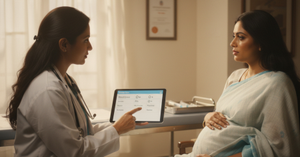When we think of heart disease, we rarely picture a child. But the modern reality is quietly shifting. With rising cases of childhood obesity, hypertension, early-onset diabetes, and even heart rhythm abnormalities, the question is no longer if children can have heart issues but why they do.
While the image of a child evokes innocence and vitality, the silent threats to their cardiovascular health are becoming more pronounced and often start far earlier than we think. The heart, even in childhood, can reflect the impact of genetics, environment, diet, inactivity, emotional stress, and modern-day pollutants.
Let’s explore what really affects heart health in children today and how we, as parents, caregivers, and educators, can intervene early and meaningfully.
1. Lifestyle Habits: The Foundation of Heart Health
A. Poor Diets
Many Indian children grow up with diets high in:
- Refined carbs (white bread, noodles, biscuits)
- Processed snacks (chips, sugary drinks, instant foods)
- Fried and salty items
These contribute to:
- High cholesterol
- Insulin resistance
- Obesity-related heart strain
Skipping breakfast, eating late at night, and emotional eating due to academic stress only make matters worse.
B. Lack of Physical Activity
Increased screen time, academic pressure, and reduced outdoor play mean that many children:
- Do not get the recommended 60 minutes of daily physical activity
- Have reduced cardiopulmonary endurance
- Show early signs of sedentary lifestyle diseases
C. Sleep Deprivation
Children sleeping less than 8–9 hours a night are at higher risk of:
- High blood pressure
- Poor sugar regulation
- Mood and behavioral issues
- Altered metabolism affecting heart health
2. Environmental and Urban Stressors
A. Air Pollution
Especially in urban Indian cities, children inhale high levels of PM2.5 particles, carbon monoxide, and ozone all of which:
- Trigger systemic inflammation
- Elevate blood pressure
- Increase risk of asthma and long-term vascular damage
B. Noise Pollution and Stress
Constant noise honking, traffic, and school pressures can increase resting heart rate and cortisol, indirectly putting strain on a child’s heart.
C. Passive Smoking
Children exposed to secondhand smoke at home face:
- Early stiffening of arteries
- Higher rates of respiratory and cardiac complications
3. Rising Childhood Obesity and Metabolic Syndrome
India is witnessing a dual burden of under-nutrition in some regions and over-nutrition in urban and semi-urban children. Childhood obesity is no longer “baby fat,” it’s a strong predictor of:
- Hypertension
- Type 2 diabetes
- Early-onset atherosclerosis (narrowing of arteries)
Alarmingly, some children as young as 10 years old are being diagnosed with fatty liver and prediabetes conditions once seen in adults.
4. Genetic and Family Risk Factors
Some children may appear healthy, but have underlying genetic risks, such as:
- Familial hypercholesterolemia (very high LDL cholesterol)
- Congenital heart defects (present since birth)
- Arrhythmias and inherited cardiomyopathies
Family history of:
- Early heart attacks (<55 in men, <65 in women)
- Sudden cardiac death
- Diabetes, hypertension, or stroke
5. Emotional Health and the Heart-Brain Axis
Children today face academic pressure, social competition, and screen-induced overstimulation, all of which can:
- Increase cortisol and adrenaline
- Affect heart rhythm
- Raise blood pressure
Chronic anxiety, bullying, or trauma can also create psychosomatic symptoms chest pain, palpitations, or breathlessness, that mimic heart disease.
While not always structural in nature, these symptoms are real and impactful and require psychological care and emotional validation, not just ECGs.
6. The Silent Rise of Hypertension in Children
Studies from Indian metros have reported that 5–10% of school-aged children may already have elevated blood pressure. Causes include:
- Excessive salt intake
- Obesity and inactivity
- Undiagnosed kidney or hormonal issues
- Sleep apnea due to enlarged adenoids or obesity
Regular BP checks should not be limited to adults; they must begin in childhood, especially for at-risk kids.
7. Inflammatory Triggers: Infections and Autoimmune Disorders
Certain illnesses can have a direct or delayed impact on the heart:
- Rheumatic fever: Still common in rural India; can damage heart valves
- Kawasaki disease and MIS-C (linked to COVID): Can cause coronary artery inflammation in young children
- Juvenile lupus and other autoimmune conditions: May involve the heart or blood vessels
These conditions are reminders that fever, rashes, or fatigue in children should not be ignored, especially if they linger or recur.
So, Are Our Kids’ Hearts at Risk? Yes But There’s Hope
The good news is that children’s hearts are incredibly adaptable and resilient, if neutered early. Cardiovascular disease is often preventable, and many risk factors are modifiable with awareness and small, daily actions.
What Parents and Schools Can Do Today
- Encourage outdoor play over screen time
- Replace sugary snacks with fruits, nuts, and whole grains
- Get annual check-ups that include BP, BMI, and lipid profiles
- Ask about family history of heart disease
- Reduce passive smoke exposure at home
- Advocate for heart-friendly school meals
- Teach children about stress management and emotional expression
- Ensure 8–10 hours of sleep per night, even during exams
- Seek early medical advice for fatigue, chest pain, or fainting episodes
Conclusion: Building a Heart-Smart Generation
Today’s children are tomorrow’s adults. Protecting their hearts now is not just a medical responsibility, it's a societal commitment. If we focus only on academic marks and physical height, but not on the beat of their growing hearts, we miss the essence of holistic health.
With timely awareness, inclusive conversations, and proactive care, we can break the cycle of early cardiovascular disease and build a future where strong hearts begin in childhood, not after illness.








Be the first one to comment on this story.